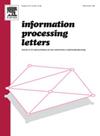Improved hardness of approximation for Geometric Bin Packing
IF 0.6
4区 计算机科学
Q4 COMPUTER SCIENCE, INFORMATION SYSTEMS
引用次数: 0
Abstract
The Geometric Bin Packing (GBP) problem is a generalization of Bin Packing where the input is a set of d-dimensional rectangles, and the goal is to pack them into d-dimensional unit cubes efficiently. It is NP-hard to obtain a PTAS for the problem, even when . For general d, the best-known approximation algorithm has an approximation guarantee that is exponential in d. In contrast, the best hardness of approximation is still a small constant inapproximability from the case when . In this paper, we show that the problem cannot be approximated within a factor unless .
Recently, d-dimensional Vector Bin Packing, a problem closely related to the GBP, was shown to be hard to approximate within a factor when d is a fixed constant, using a notion of Packing Dimension of set families. In this paper, we introduce a geometric analog of it, the Geometric Packing Dimension of set families. While we fall short of obtaining similar inapproximability results for the Geometric Bin Packing problem when d is fixed, we prove a couple of key properties of the Geometric Packing Dimension which highlight fundamental differences between Geometric Bin Packing and Vector Bin Packing.
改进了几何料仓包装的近似硬度
几何Bin Packing (GBP)问题是Bin Packing的一种推广,其输入是一组d维矩形,目标是将它们有效地打包成d维单位立方体。即使当d=2时,获得问题的PTAS也是np困难的。对于一般的d,最著名的近似算法在d上有一个指数级的近似保证。相反,最好的近似硬度仍然是d=2时的一个很小的常数不逼近性。在本文中,我们证明除非NP=P,否则问题不能在d1−ε因子内近似。最近,研究了一个与GBP密切相关的d维向量装箱问题,当d是一个固定常数时,利用集合族的装箱维数的概念,证明了在Ω(log d)因子内难以近似。本文引入了它的一个几何类比,即集合族的几何填充维数。当d固定时,我们无法得到类似的几何装箱问题的不可逼近性结果,但我们证明了几何装箱维数的几个关键性质,突出了几何装箱与向量装箱的根本区别。
本文章由计算机程序翻译,如有差异,请以英文原文为准。
求助全文
约1分钟内获得全文
求助全文
来源期刊

Information Processing Letters
工程技术-计算机:信息系统
CiteScore
1.80
自引率
0.00%
发文量
70
审稿时长
7.3 months
期刊介绍:
Information Processing Letters invites submission of original research articles that focus on fundamental aspects of information processing and computing. This naturally includes work in the broadly understood field of theoretical computer science; although papers in all areas of scientific inquiry will be given consideration, provided that they describe research contributions credibly motivated by applications to computing and involve rigorous methodology. High quality experimental papers that address topics of sufficiently broad interest may also be considered.
Since its inception in 1971, Information Processing Letters has served as a forum for timely dissemination of short, concise and focused research contributions. Continuing with this tradition, and to expedite the reviewing process, manuscripts are generally limited in length to nine pages when they appear in print.
 求助内容:
求助内容: 应助结果提醒方式:
应助结果提醒方式:


